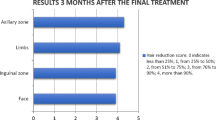Abstract
Complications of laser hair reduction should be classified not only to skin and ocular complications but to skin, ocular, and scalp hair complications. Do not forget the plumes. Awareness about laser dangers is very critical. In this way, able to progress the security of both patients and laser providers. Does Nd: YAG cause more bad effect than Alexandrite on scalp hair melanin of laser providers and why? The study aimed at detecting the effect of cumulative exposure to scattered beam during laser hair reduction on the laser providers which may cause unexpected scalp hair melanin affection. The study included 150 female subjects: One hundred medical personnel engaged in laser-assisted hair reduction procedure; half of them were wearing head cover (hijab) and 50 female subjects not dealing with hair reduction laser systems (half of them were wearing hijab). Two laser devices were used: Alexandrite laser (GentleLase PRO® 755 nm, Candela Corp., Wayland, MA, USA) and neodymium-doped Yttrium Aluminium Garnet (Nd: YAG) (Synchro HP 1064 nm, Deka M.E.L.A s.r.l., Calenzano (FI), Italy) laser. A significant higher number of grey hairs in medical personnel (P < 0.001) was evident at the initial examination and at each follow-up visit thereafter. The number of grey hairs at initial assessment, after 6 months and after 1 year, was significantly higher in medical personnel dealing with Nd: YAG laser than those using long-pulsed Alexanderite laser (P < 0.001 each). A noteworthy positive correlation was found between working years, grey hair number at the start of study, and the progression (excess) in number of grey hairs after 1 year regardless of the laser system used. It seems that scalp hair pigment needs specific protection as does the eye pigment. Greater attention should be paid to possible long-term hazards particularly on service providers.
Similar content being viewed by others
References
Al Taleb RM, Alsharif HM, Younis AS et al (2019) Adherence to optical safety guidelines for laser-assisted hair removal. Photodermatol Photoimmunol Photomed. 35(5):313–317. https://doi.org/10.1111/phpp.12473
United States Food and Drug Administration. Radiation‐emitting products. Washington, DC: FDA, NY
Gan SD, Graber EM (2013) Laser hair removal: a review. Dermatol Surg 39(6):823–38. https://doi.org/10.1111/dsu.12116
Anderson RR (1994) Laser-tissue interactions. In: Goldman M, Fitzpatrick RE (eds) Cutaneous Laser Surgery. St. Louis, Missouri, Mosby-Year Book, pp 1–18
Dover JS, Arndt KA, Geronemus RG, et al (1990) Illustrated cutaneous laser surgery: a practitioner’s guide. Norwalk, CT: Appleton & Lange; [Google Scholar] [Ref list]
Patil UA, Dhami LD (2008) Overview of lasers. Indian J Plast Surg 41(Suppl):S101–S113
Berry R, Cahill F, Chadwick P (2019) Electrical trade practices. 2nd edition
Elkin Z, Ranka MP, Kim ET et al (2011) Iritis and iris atrophy after eyebrow epilation with alexandrite laser. Clin Ophthalmol 5:1733–1735
Lolis M, Dunbar SW, Goldberg DJ et al (2015) Patient safety in procedural dermatology: part II. Safety related to cosmetic procedures. J Am Acad Dermatol 73(1):15–24
Chuang GS, Farinelli W, Christiani DC et al (2016) Gaseous and particulate content of laser hair removal plume. JAMA Derm 152:1320–1326. https://doi.org/10.1001/jamadermatol.2016.2097
Tobin DJ, Bystryn JC (1996) Different populations of melanocytes are present in hair follicles and epidermis. Pigment Cell Res 9:304–310
Findlay GH (1982) An optical study of human hair colour in normal and abnormal conditions. Br J Dermatol 107:517–27
Keogh EV, Walsh RJ (1965) Rate of greying of human hair. Nature 207:877–878
Pandhi D, Khanna D (2013) Premature graying of hair. Indian J Dermatol Venereol Leprol 79(5):641–653. https://doi.org/10.4103/0378-6323.116733
Arck PC, Overall R, Spatz K et al (2006) Towards a “free radical theory of graying”: melanocyte apoptosis in the aging human hair follicle is an indicator of oxidative stress induced tissue damage. FASEB J 20:1567–1569
Kadekaro AL, Kavanagh RJ, Wakamatsu K et al (2003) Cutaneous photobiology. The melanocyte vs. the sun: who will win the final round? Pigment Cell Res 16:434–47
Emerit I, Filipe P, Freitas J, Vassy J (2004) Protective effect of superoxide dismutase against hair graying in a mouse model. Photochem Photobiol 80:579–582
Rasheed AI (2009) Uncommonly reported side effects of hair removal by long pulsed-alexandrite laser. J Cosmet Dermatol 8(4):267–274. https://doi.org/10.1111/j.1473-2165.2009.00465.x
Radmanesh M, Mostaghimi M, Yousefi I et al (2002) Leukotrichia developed following application of intense pulsed light for hair removal. Dermatol Surg 28:572–574
Tobin DJ (2009) (2009) Aging of the hair follicle pigmentation system. Int J Trichology 1:83–93
Liew SH, Grobbelaar A, Gault D et al (1999) Hair removal using the ruby laser: clinical efficacy in Fitzpatrick skin types I-V and histological changes in epidermal melanocytes. Br J Dermatol 140:1105–1109
Reda AM (2000) Efficacy and safety of long-pulsed alexandrite laser with dynamic cooling device (DCD) for hair removal in skin types II-V. Laser Surg Med 125:20
Thomas MM (2019) Houreld NN (2019) The “ins and outs” of laser hair removal: a mini review. J Cosmet Laser Ther 21(6):316–322. https://doi.org/10.1080/14764172.2019.1605449
Lim SPR, Lanigan SW (2006) Review of the adverse effects of laser hair removal. Lasers Med Sci 21:121–125. https://doi.org/10.1007/s10103-006-0377-y
Wanner M (2005) Laser hair removal. Dermatol Ther 18:209–216
Funding
These were the authors’ own work.
Author information
Authors and Affiliations
Corresponding author
Ethics declarations
Ethical approval
The manuscript has been read and approved by all the authors, and each author believes that the manuscript represents honest work.
Conflict of interest
The authors have declare no competing interests.
Additional information
Publisher's note
Springer Nature remains neutral with regard to jurisdictional claims in published maps and institutional affiliations.
This research was conducted in Dermatology, Venereology & Andrology Department Faculty of Medicine, Benha University, Egypt.
Rights and permissions
About this article
Cite this article
Elhabak, D.M., Shams, G.M. What else than eyes need special protectors during laser hair reduction sessions?. Lasers Med Sci 37, 913–918 (2022). https://doi.org/10.1007/s10103-021-03334-w
Received:
Accepted:
Published:
Issue Date:
DOI: https://doi.org/10.1007/s10103-021-03334-w




